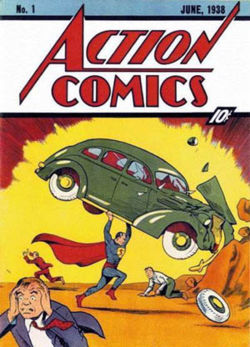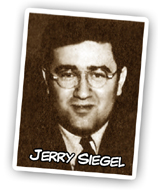Co-ownership of Superman: What does it mean?
In an historic judgment, the wife and daughter of writer Jerry Siegel now share the rights to Superman with the titan Time Warner. So, how will this affect the Man of Steel in the future?
Federal District Court Judge Stephen G. Larson ruled in Los Angeles on Wednesday, 26 March, that Joanne Siegel and Laura Siegel Larson, the widow and daughter of Superman co-creator Jerome Siegel, were entitled to a share of the character's United States copyright.
 According to MICHAEL CIEPLY of THE NEW YORK TIMES, the judge’s 72-page summary judgment upheld the Siegels’ copyright in Action Comics #1, in which the classic Superman cape and Clark Kent alter-ego already were established.
According to MICHAEL CIEPLY of THE NEW YORK TIMES, the judge’s 72-page summary judgment upheld the Siegels’ copyright in Action Comics #1, in which the classic Superman cape and Clark Kent alter-ego already were established.
This is a posthumous victory for Jerry Siegel, who went to his grave in 1996 still bitter about letting go of the soon-to-be astoundingly lucrative hero for a paltry $130.
Time Warner declined to discuss the decision, but issued a statement saying: "substantial issues relating to the accounting of profits were ruled in our favor."
Larson's ruling applies to domestic returns for all Superman projects since April 16, 1999. The ruling left intact Time Warner’s international rights; DC does not need to account for profits earned outside the U.S.
Reserved for trial is how much the company may owe for use of the character since '99. Also to be resolved is whether the Siegels are entitled only to a cut of DC’s Superman profits or if the Warner Brothers film unit will be included. Income from a Superman Returns sequel might require payments to the Siegels, should they prevail in a demand that the studio’s income be subject to an audit. Plus, Warner may end up paying tens of millions from the domestic receipts of Superman Returns itself.
So, what happens now? According to blogger JEFF TREXLER, "More documents prepared and answered; more rulings; possibly a trial; perhaps an appeal. The most likely final outcome: a settlement."
Additionally, the question of co-creator Joseph Shuster’s share of Superman will need to be answered in the near future. Shuster's heirs are eligible to sue in five years.
"As the Shuster claim comes through his estate rather than his direct heirs, there may be some differences in the situation that do not break the estate’s way," NYC attorney Brendan McFeely, an intellectual property specialist active in the comics field, told ANDY KHOURI at CBR NEWS.
In the meantime, do the Siegels have creative control over Superman comics? No.
Judge Larson's decision only grants the heirs a copyright interest in the Superman material that Siegel and Shuster created before they were producing "work for hire." This amounts to the material in Action Comics #1. Many (in fact, most) recognizable elements of the Superman universe did not appear in the first issue of Action, but were added to the mythos long afterward. Among these are Brainiac and the Bottle City of Kandor, the Phantom Zone, the Fortress of Solitude, Mr. Mxyzptlk, even Perry White and Jimmy Olsen.
Most likely, Time-Warner simply will pay through the nose for the exclusive use of Superman. However, JAMES HUNT at DEN OF GEEK! addressed fans' fears over the effect on the character by explaining that a Siegel licensed Man of Steel would be forced to do without Lex Luthor (first appearance: Action Comics #23, as a redhead!), Kryptonite (invented for the radio show), Metropolis (the city is unnamed in #1), The Daily Planet (Clark works for The Daily Star), and...flight. That's right, in his early appearances, the Man of Tomorrow couldn't do much more than "leap tall buildings in a single bound."
So, that leaves speed, strength, invulnerability, (some form of) an S-shield, Clark Kent and Lois Lane. This means, to Hunt at least, the Siegel judgment is "not quite the bombshell for DC or the character that it might initially seem."
 But, a landmark decision has been made, the impact of which will not be felt fully for some time.
But, a landmark decision has been made, the impact of which will not be felt fully for some time.
"This is a ringing endorsement for the right of a creator or his heirs to recapture copyright that was previously negotiated away before the creator could know the ‘real value’ of a property," McFeely remarked.
"Siegel and Shuster's creation generated an immense amount of wealth; it only seems fair for them to benefit," wrote Trexler. "Although some may object that it's too late--Siegel and Shuster have passed on--we should note that many creators work in part to provide a legacy for their families."
[Thanks to JARROD SARAFIN at MANIA and to VFXWORLD.]